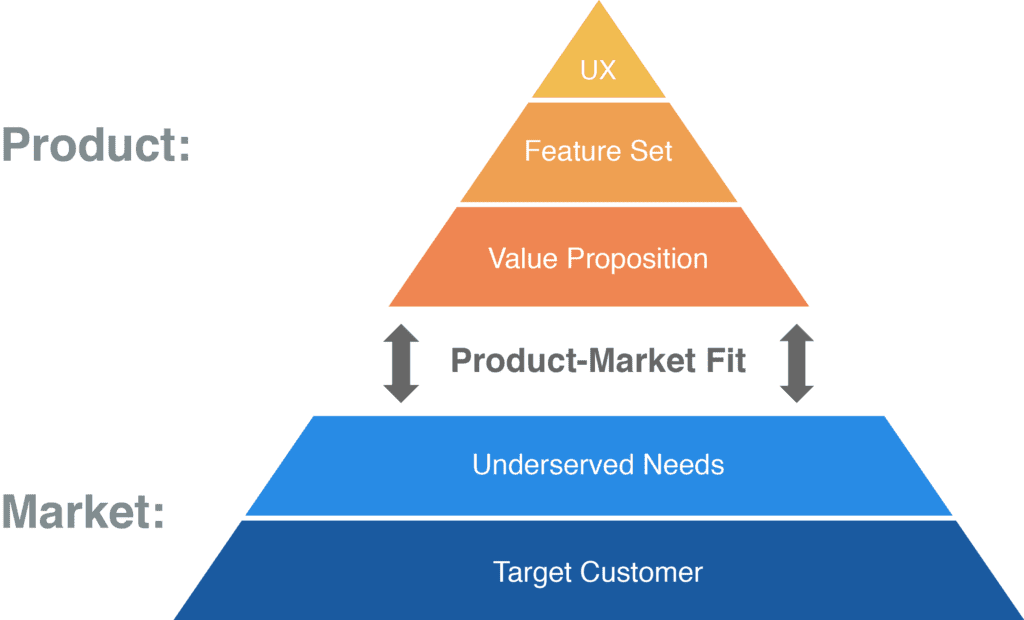A Playbook for Achieving Product Market Fit

Product-market fit is a critical concept in Lean Startup methodology, and understanding how to achieve it is paramount. Coined by Marc Andreessen in a 2007 blog post, product-market fit is defined as being in a good market with a product that can satisfy that market. Despite its importance, detailed guidance on achieving product-market fit is often lacking in many articles.
Product Market Fit Pyramid
 The Product-Market Fit Pyramid, a framework introduced in The Lean Product Playbook based on extensive experience provides a structured approach to defining and achieving product-market fit. This actionable model comprises five key components, forming layers of a pyramid, each directly influencing the levels above and below. These components are your target customer, your customer’s underserved needs, your value proposition, your feature set, and your user experience (UX).
The Product-Market Fit Pyramid, a framework introduced in The Lean Product Playbook based on extensive experience provides a structured approach to defining and achieving product-market fit. This actionable model comprises five key components, forming layers of a pyramid, each directly influencing the levels above and below. These components are your target customer, your customer’s underserved needs, your value proposition, your feature set, and your user experience (UX).
The Lean Product Process
To navigate the path to product-market fit, the Lean Product Process, outlined in The Lean Product Playbook, offers a step-by-step, iterative approach based on the Product-Market Fit Pyramid. This process facilitates articulating, testing, and revising key hypotheses, enhancing the product-market fit progressively.
The Lean Product Process consists of six steps:
- Determine your target customer
- Identify underserved customer needs
- Define your value proposition
- Specify your MVP feature set
- Create your MVP prototype
- Test your MVP with customers
Step 1: Determine your target customer
It all begins with target customers who will ultimately decide how well your product meets their needs. You should use market segmentation to get specific about who your target customer is. Personas are a great way to describe your target customer so that everyone on the product team understands for whom they should be designing and building the product.
Step 2: identify underserved customers’ needs
With your MVP prototype ready, solicit feedback from target customers. Ensure participants align with your target market through screeners. Conduct one-on-one sessions, closely observing customer interactions and asking open-ended questions. Testing in batches helps identify patterns in feedback, guiding iterative improvements.
Step 3: Define your value proposition
Your value proposition is your plan for how your product will meet customer needs better than the alternatives. Out of all the potential customer needs your product could address, which ones will you focus on with your product?
Steve Jobs said, “People think focus means saying yes to the thing you’ve got to focus on. But that’s not what it means at all. It means saying no to the hundred other good ideas that there are. You have to pick carefully. I’m actually as proud of the things we haven’t done as the things I have done. Innovation is saying no to 1,000 things.”
You need to figure out how your product will be differentiated from competitive products. How will your product outperform the others? What unique features of your product will delight customers? This is the essence of product strategy.
Step 4: Specify your MVP feature set
Once you are clear on your value proposition, you need to specify what functionality your minimum viable product will include. You don’t want to spend too much time and effort toiling away only to find out later that customers don’t like the product you’ve built. The MVP approach is aimed at building only what is needed to create enough value in the eyes of your target customer to validate that you are heading in the right direction.
Customers may end up telling you that your MVP lacks an important piece of functionality. Or they may tell you that they wouldn’t use a particular feature that you decided to include in your MVP. The goal is to iterate until you have an MVP that customers agree is viable.
Step 5: Create your MVP prototype
In order to test your MVP hypotheses with customers, you need to show them a version of your product so they can give you feedback on it. You will need to apply user experience (UX) design to bring your feature set to life for your customers.
While you could build a live, working version of your MVP, it’s usually faster and more prudent to create an MVP prototype. A prototype is a representation of your product that you create without having to build your actual product.
Prototypes can vary in fidelity—the level of detail to which they resemble the final product—and interactivity—the degree to which the user can interact with the prototype compared to the final product. A hand sketch of your product (on paper or a whiteboard) would be low fidelity and low interactivity. For web and mobile products, medium-fidelity wireframes and high-fidelity mockups are frequently used.
You can use a set of high-fidelity mockups of your product’s pages/screens to create a clickable/tappable prototype. Prototyping tools (such as InVision) make it easy to specify clickable/tappable hot spots and link them to other pages/screens. Such prototypes can usually simulate the user experience of the final product with enough fidelity and interactivity to obtain valuable feedback from customers. Prototypes are a powerful way to look before you leap.
Step 6: Test your MVP with customers
Once you have your MVP prototype ready, it’s time to test it with customers. It’s important in this step to ensure the people from whom you are soliciting feedback are in your target market. If you don’t, you risk receiving customer feedback that can send you iterating in the wrong direction. A screener—a short survey to ensure research participants have the attributes of your target customer—helps achieve this goal. You then schedule time to speak with each customer one-on-one.
During the user test you want to carefully observe what the customer says and does as they use the prototype. You should also ask clarifying questions when appropriate to gain deeper learning. Asking questions is an important skill to gain the most value from user tests. A good moderator will avoid asking leading questions such as, “That was easy, wasn’t it?” Compared to a non-leading question, a leading question biases the response from the customer.
A good interviewer will also avoid asking closed questions such as, “Do you like that feature?” Such questions mandate a yes or no response from the user, which doesn’t provide much learning. Instead, you should ask open-ended questions such as “Could you please tell me what you thought of that feature?” Non-leading, open-ended questions give customers latitude in their answers and also encourage them to tell you more.
It’s beneficial to conduct user tests in batches or waves. A wave of five to eight users strikes a good balance between too few (where you risk not detecting some issues) and too many (where there is repetition and low incremental value of additional tests). At the end of the wave, you want to look across all the feedback you’ve received, both positive and negative. You want to identify patterns of similar feedback from multiple customers and prioritize any customer concerns that you’ve uncovered so you can address them.
Iterate to Improve Product-Market Fit
The Lean Product Process is iterative. Analyzing customer feedback guides revisions, and you loop back to earlier steps as needed. Whether refining UX design or adjusting major hypotheses, each iteration involves testing with new waves of target customers. Positive feedback increases, negative feedback decreases, and progress becomes evident. There is no one single MVP- Multiple MVPs are needed to achieve a successful product market fit
For high confidence in product-market fit, repeat the Lean Product Process through multiple waves, revising hypotheses based on customer feedback. If progress stagnates, consider a pivot in major hypotheses. Ultimately, achieving product-market fit signifies validated key hypotheses, a product design with strong fit, and readiness to invest in building a valuable product.
For organizations seeking guidance on implementing Lean Startup principles, reach out to us today for a tailored solution through a no-pressure call.
FAQs
What is product-market fit?
Product-market fit is when a product meets the needs of a specific market in a way that competitors cannot match. It is a critical concept in Lean Startup methodology.
How can I achieve product-market fit?
To achieve product-market fit, you need to determine your target customer, identify their underserved needs, define your value proposition, specify your MVP feature set, create an MVP prototype, and test it with customers.
Why is product-market fit important?
Product-market fit is essential because it ensures that your product is meeting the needs of your target market effectively, leading to customer satisfaction, retention, and ultimately, business success.
Is the Lean Product Process iterative?
Yes, the Lean Product Process is iterative, meaning that you will continuously analyze customer feedback, make revisions, and loop back to earlier steps as needed to improve your product-market fit.
